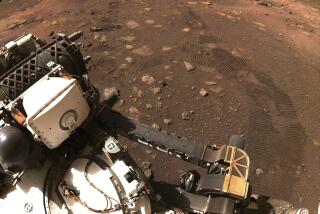Photos Show Opportunity Hit Pay Dirt
NASA’s Opportunity rover “scored a 300-million-mile hole in one,” landing in the middle of a Martian crater and returning images Sunday of a “bizarre alien landscape” that is puzzling and entrancing geologists.
“I’m flabbergasted. I’m astonished. I’m blown away,” said principal investigator Steve Squyres of Cornell University.
“My fondest hope was that we would land close enough to a crater to get to the layered material” that seems to characterize the Meridiani Planum landing site, “and here we are inside a small [one],” he said.
The first black-and-white panoramic image sent back by the lander indicated that Opportunity, which reached Mars on Saturday, was almost in the middle of a crater roughly 20 yards in diameter and 6 feet deep.
The rover also transmitted its first color image, which showed a grayish-brown terrain darker than the soil at any previous landing site. The pictures also showed outcroppings of bedrock that immediately became potential targets for Opportunity once it begins roving the surface in a couple of weeks.
The presence of bedrock only a few yards from the lander clearly excited geologists.
“One of the things about bedrock is that you know where it came from,” Squyres said. “These rocks grew up right in this neighborhood.”
The outcrop could have been formed either by sediment accumulating on the bottom of a lake bed or by the accumulation of volcanic rock. The team hopes to learn which is the case when the rover gets close to the rocks and examines them with its sophisticated instruments. By determining which trace minerals are present along with the rock, geologists will be able to tell how it formed.
The first photos also showed bright splotches of red soil where the lander bounced on its air bags, scraping away the unusual surface layer and exposing a soil underneath similar to that seen at other landing sites.
Before the landing, Squyres said, “I kept thinking that this couldn’t possibly get any better, and it just does.”
He noted that, “In principle, we could spend most of the mission in this little crater and do wonderful things. But there is much better stuff to be had out there.”
In particular, there is a much larger crater, about 170 yards across, roughly half a mile away.
Mission controllers predicted the rover would have no difficulty climbing the shallow rim of the crater to explore the rest of the plains.
The air bag-encased lander hit the Martian surface at 9:05 p.m. Saturday, rolling to a stop a few minutes later. Unlike its twin, Spirit, which landed in an upright position Jan. 3 on the other side of Mars at Gusev Crater, Opportunity landed on one side of the pyramid-shaped capsule containing it.
But the craft quickly righted itself, deployed its solar panels and began taking snapshots of its surroundings.
And this time, the collapsed air bags were completely retracted so they were not blocking the rover’s primary roll-off route, as was the case with Spirit. Engineers at NASA’s Jet Propulsion Laboratory in Pasadena delayed Spirit’s roll-off for three days before finally deciding to use a secondary ramp to leave the lander.
Opportunity’s roll-off will probably also be delayed slightly as engineers grapple with a malfunction that has idled Spirit since Wednesday.
Project manager Peter Theisinger said Sunday that they were making good progress.
“The patient is well on the way to recovery, and there is a very good chance that we will have a very good rover when we get it back up,” he said. “But that is going to take a couple or three weeks.”
On Wednesday, Spirit stopped transmitting data, sending back only occasional bursts of “pseudo-noise,” random collections of digital zeros and ones.
During this period, the craft’s onboard computer rebooted itself more than 130 times, and the craft refused to go to sleep during the long, cold Martian nights.
Finally, overnight Friday, the team was able to reestablish control of the rover, and team members began capturing data about its systems. They concluded that the crux of the problem was in Spirit’s flash memory, a short-term memory similar to the memory sticks in a digital camera.
They regained control of the craft by bypassing the flash memory. Theisinger said Sunday that controllers were able to downlink the contents of the flash memory and were studying it to see what had gone wrong.
The most likely possibility is that there is an inherent problem in the software associated with the flash memory. If that is the case, the problem would also afflict Opportunity, but it most likely could be repaired by sending both craft new software instructions.
Less likely is that the malfunction was triggered by some kind of a mechanical problem that sent conflicting information to the craft’s computer. If that is the case, Opportunity is not likely to share the problem.
The least likely possibility is that the malfunction was caused by a solar event that flooded the surface of Mars with heavy ions or neutrons. The flash memory is susceptible to problems if it is hit by such particles while reading or writing data. The event was detected by an instrument on the Mars Odyssey orbiter, but not by instruments on Earth.
The team is checking to determine whether the malfunction coincided with the solar flare.
More to Read
Sign up for Essential California
The most important California stories and recommendations in your inbox every morning.
You may occasionally receive promotional content from the Los Angeles Times.










